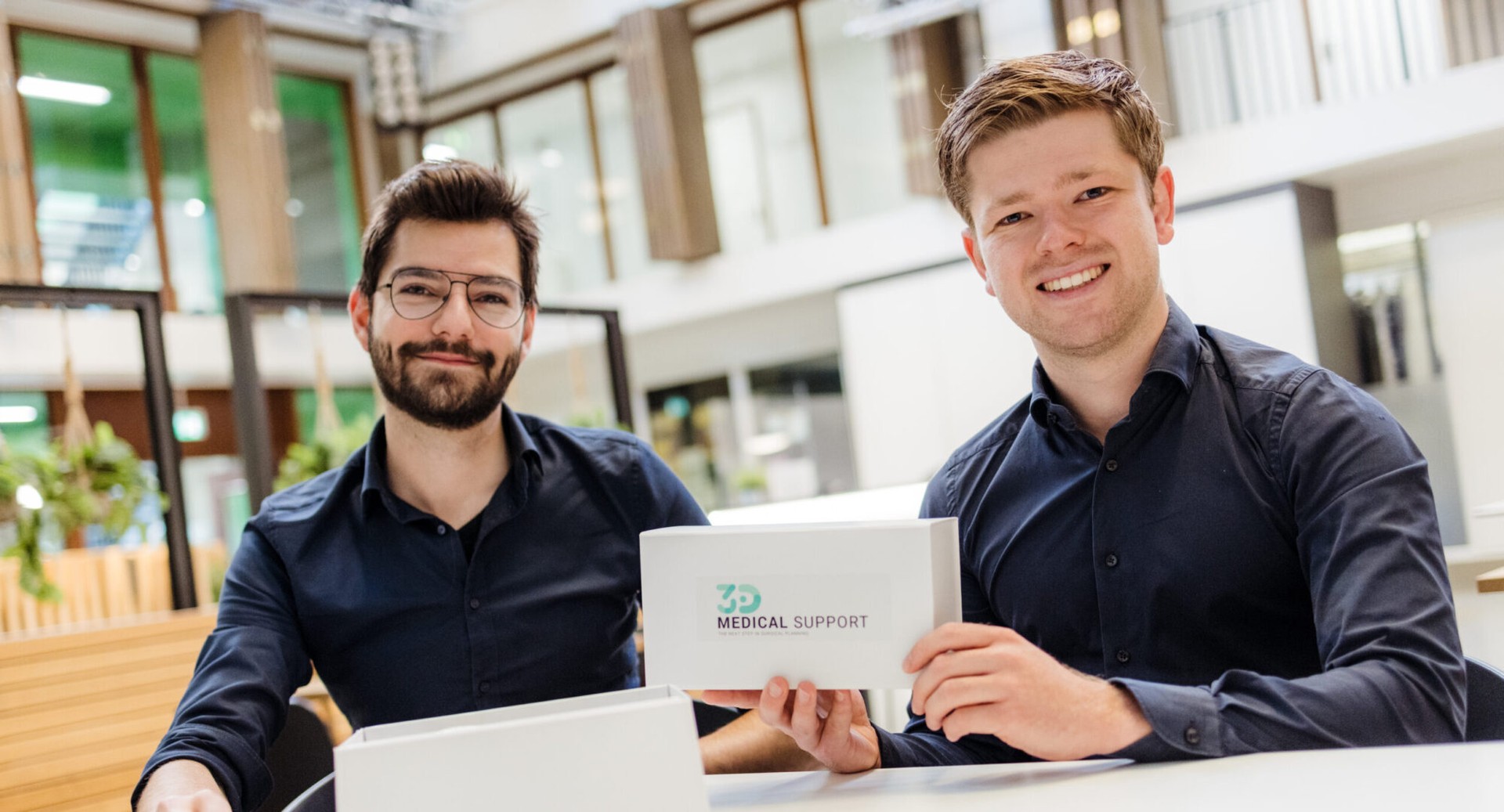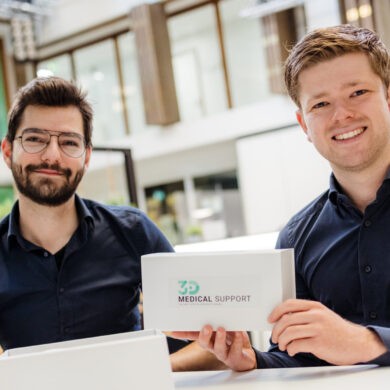cases >> 3D Medical Support
3D MODELS AS TOOL DURING SURGERIES.

3D MODELS AS TOOL DURING SURGERIES.
What started as a project for the Mechanical Engineering master’s program has since grown into the startup 3D Medical Support, which is making an impact in hospitals across Europe. Rutger Visser and Chiel de Nijs use their technical know-how to assist surgeons during complex procedures with their realistic 3D models based on CT scans. Rutger: “Our 3D prints boost the confidence surgeons have in their plans.”
Prototype for surgeries
Imagine being a surgeon and you’re about to perform a life-saving operation. All you have to go on are a 2D CT scan, a messy sketch and your own best estimate of what you’re dealing with. How confident would you be in the procedure’s success? Rutger and Chiel felt there had to be a better way, so they came up with a solution: 3D printed models based on a CT scan of the patient. “Various 3D models are used all the time in the world of engineering, especially when dealing with critical components,” Rutger says. “For physicians, however, overlooking something important during a surgery can have serious consequences. That is where a 3D model based on the patient’s CT data can help.” Chiel adds: “It was obvious to us: in engineering, you always start with a prototype. A CT scan alone offers a limited perspective with no sense of scale. When you only have one chance to get it right, a 3D model is very helpful.”
One-eighth the width of a human hair
All a physician has to do is forward a patient’s CT data to Rutger and Chiel. Chiel explains: “A CT scan is often a 2D image taken from three sides. By manipulating pixels, we can use those data to generate an accurate 3D model.” Rutger explains that the method used to print the 3D models was chosen meticulously. “We spent two years researching the best printing techniques and the most versatile material. This allows us to quickly and accurately print anatomy at one-eighth the width of a human hair using flexible and transparent material. This is important because it allows physicians to visualize how catheters, stents and other medical devices will behave on the inside of a blood vessel or heart chamber.” It is a complex task. Chiel says: “We appreciate that complexity. Especially when performing complex surgeries, the extra help is invaluable. You’re dealing with human lives, after all.”
Adding Value with 3D Printing
For students of Mechanical Engineering, launching a MedTech startup after graduating is not the most obvious career path. Rutger and Chiel initially had no intention of doing anything like that. Chiel continues: “I still had to obtain 1.5 ECs for my master’s, so I decided to do a project for which you had to come up with a solution to a complex problem and use 3D printing to add value. I knew Rutger from the pre-master’s program, so we decided to work on the project together. We discovered that a 3D model can boost surgeons’ confidence by up to 43% and that physicians would resort to a different plan in 20% of cases after realizing that the situation was different from what they had expected based on the CT data. When we explored the matter further, we learned that the 3D prints that were being used were often low in quality or so high in quality which made the prints unaffordable. As die-hard mechanical engineers, we believed we could do better. That led to the idea behind 3D Medical Support.” Rutger laughs and adds: “We got a mediocre grade for our project because we were doing something that we found interesting. After reeling in a major contract, the whole thing seems to have been worth the trouble. It is important to keep the faith and believe in your idea. If you don’t, you will inevitably fail.”
Start early
Rutger and Chiel had the technical expertise they needed and plenty of faith in their idea, but they had no clue about how to run a successful business. With a twinkle in his eyes, Rutger reveals how little they actually knew. “We knew nothing. We didn’t know what an LLC was or how to write a business plan, and we had no network. Novel-T helped us out a lot with all those things. It’s also great to have a chance to discuss with other startups that are facing similar challenges.” Chiel adds: “If you want to launch a startup, you have to start early and start small. It is an incredible experience because you learn so much about the business, entrepreneurship and yourself. This gives you many opportunities that would otherwise be out of reach.”
Working together with surgeons
Rutger and Chiel continue to seize opportunities everywhere they can. “Our goal is to be able to produce 3D models of every part of the human body: from tiny blood vessels in the brain to the smallest bones in your big toe,” Rutger says. “We want to bring together a team of people who are dedicated to specific anatomy that is ideally suited for 3D printing. We also want to see if we can reuse the waste coming out of operating rooms in order to print, without compromising the quality of our models.” The two clearly have no shortage of plans for the future. They are now eagerly seeking to collaborate with medical professionals. Chiel: “If there are any cardiologists, vascular surgeons, neurosurgeons or other medical professionals out there who want to know how our technology works, they are welcome to contact us. We look forward to working together!”

"When performing complex surgeries, the extra help is invaluable. You're dealing with human lives, after all."
Chiel de Nijs & Rutger Visser
Co-founders 3D Medical SupportMore about
3D Medical Support
What started as a project for the Mechanical Engineering master’s program has since grown into the startup 3D Medical Support, which is making an impact in hospitals across Europe. Rutger Visser and Chiel de Nijs use their technical know-how to assist surgeons during complex procedures with their realistic 3D models based on CT scans. Rutger: “Our 3D prints boost the confidence surgeons have in their plans.”






